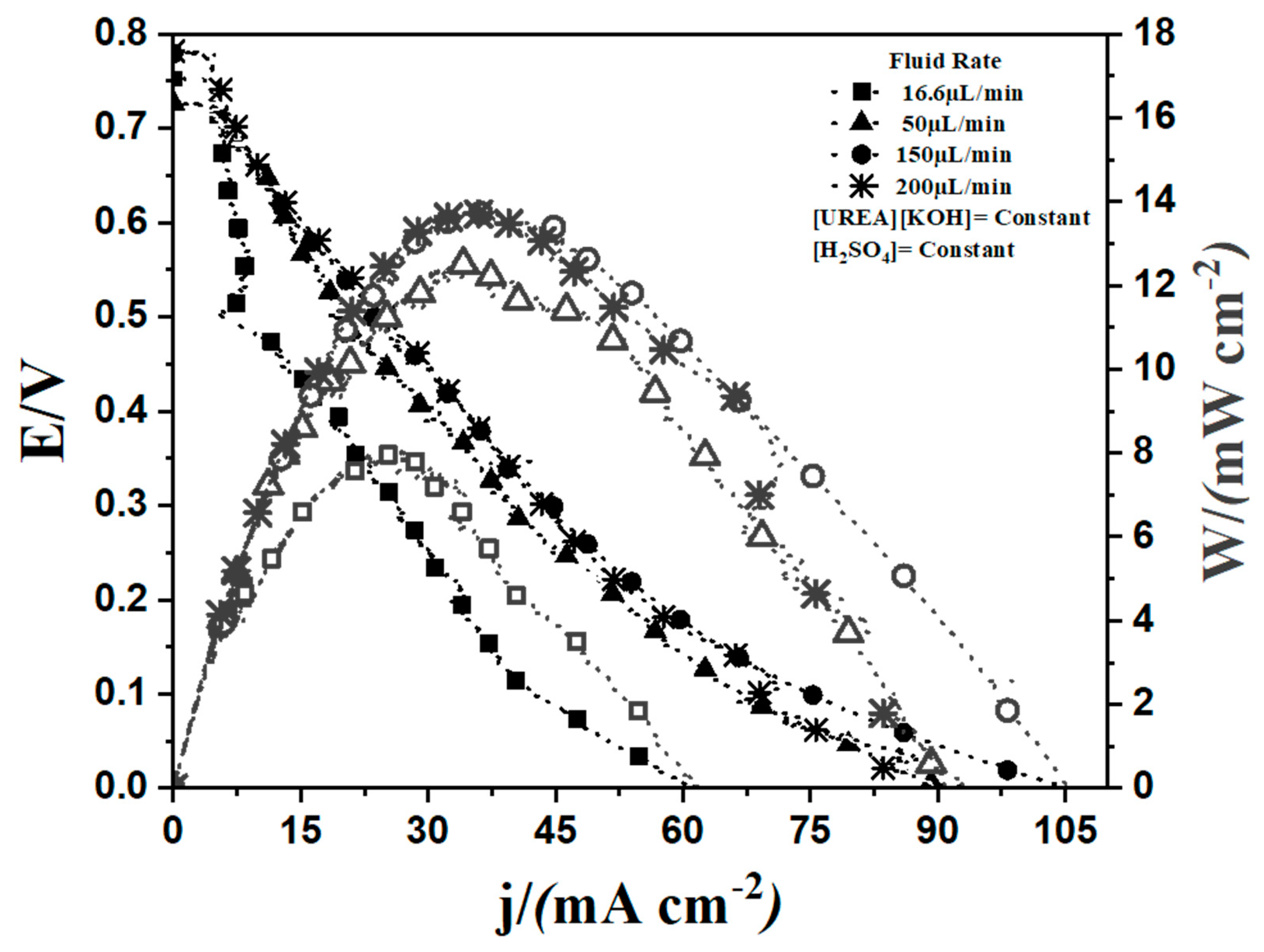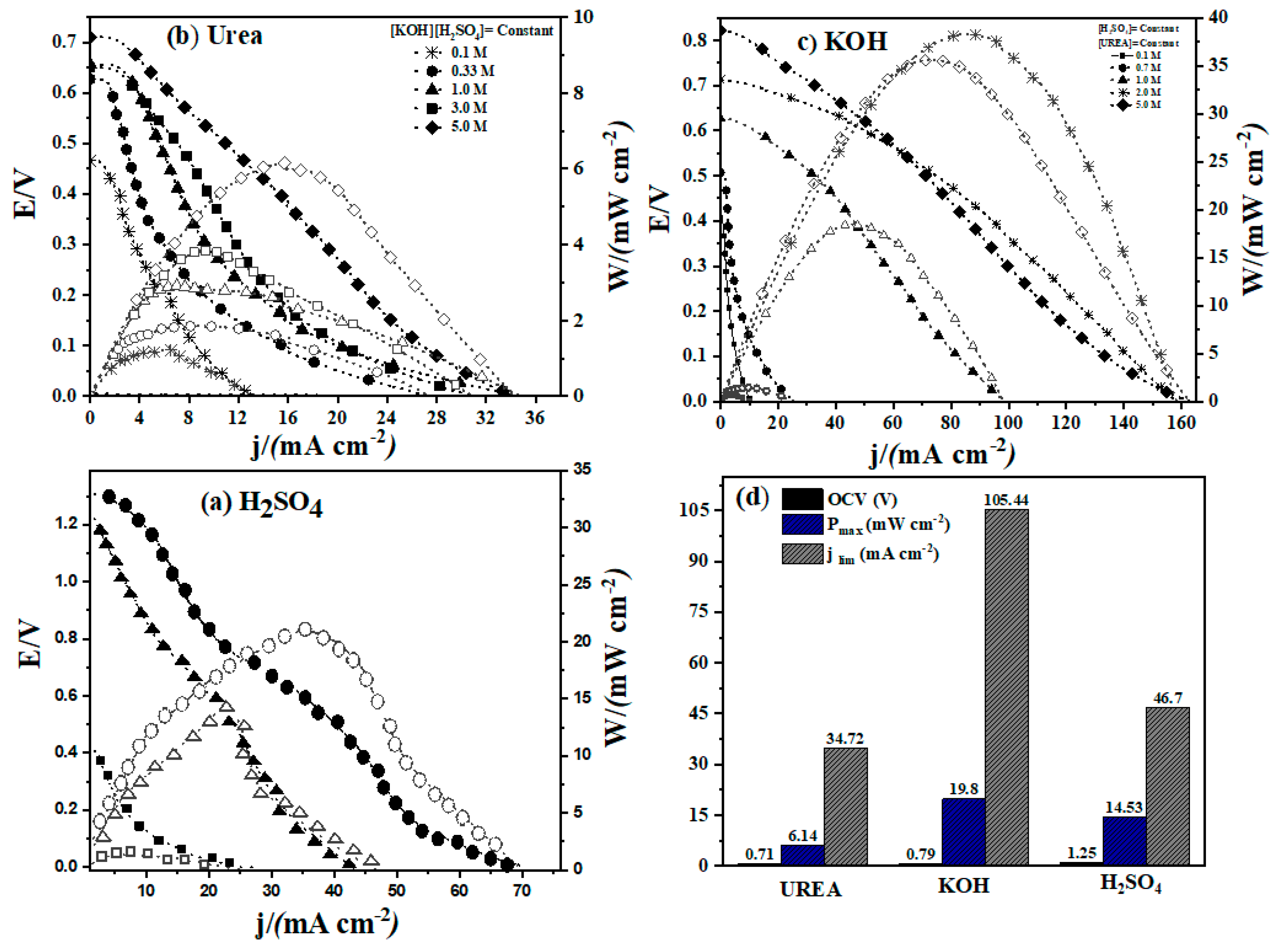Perspective of Use of Pd/rGO in a Direct Urea Microfluidic Fuel Cell
Abstract
:1. Introduction
2. Physicochemical Characterization
3. Results and Discussion
3.1. Physical Characterization
3.2. Effect of Electrolyte Flow Rate on Cell Performance
3.3. Effect of Fuel and Anolyte/Catholyte Concentration on DUµFC Performance
3.4. Evaluation of Urine Sample as Fuel
4. Materials and Methods
4.1. Construction of the DUµFC
4.2. Direct Urea Microfluidic Fuel Cell Operation
5. Conclusions
Supplementary Materials
Author Contributions
Funding
Data Availability Statement
Acknowledgments
Conflicts of Interest
References
- Sayed, E.T.; Eisa, T.; Mohamed, H.O.; Abdelkareem, M.A.; Allagui, A.; Alawadhi, H.; Chae, K.J. Direct Urea Fuel Cells: Challenges and Opportunities. J. Power Sources 2019, 417, 159–175. [Google Scholar] [CrossRef]
- Lan, R.; Tao, S.; Irvine, J.T.S. A Direct Urea Fuel Cell—Power from Fertiliser and Waste. Energy Environ. Sci. 2010, 3, 438–441. [Google Scholar] [CrossRef]
- Wang, J.H.; Zhuang, L.L.; Xu, X.Q.; Deantes-Espinosa, V.M.; Wang, X.X.; Hu, H.Y. Microalgal Attachment and Attached Systems for Biomass Production and Wastewater Treatment. Renew. Sustain. Energy Rev. 2018, 92, 331–342. [Google Scholar] [CrossRef]
- Wang, J.; Li, S.; Guo, S.; Ma, C.; Wang, J.; Sun, J. Analysis of Heat Transfer Properties of Hollow Block Wall Filled by Different Materials in Solar Greenhouse. Eng. Agric. Environ. Food 2017, 10, 31–38. [Google Scholar] [CrossRef]
- Ishii, S.K.L.; Boyer, T.H. Life Cycle Comparison of Centralized Wastewater Treatment and Urine Source Separation with Struvite Precipitation: Focus on Urine Nutrient Management. Water Res. 2015, 79, 88–103. [Google Scholar] [CrossRef] [PubMed]
- Hao, J.; Zhao, S.; Mao, R.; Zhao, X. Nickel Phosphide on Ni Foam as Anode and Peroxymonosulfate as the Chemical Oxidizer for Effective Direct Urea Fuel Cell. J. Environ. Sci. 2021, 110, 84–91. [Google Scholar] [CrossRef]
- Kim, O.H.; Choi, H.J.; Kang, S.Y.; Jang, G.Y.; Karuppannan, M.; Park, J.E.; Sung, Y.E.; Kwon, O.J.; Cho, Y.H. Towards Outstanding Performance of Direct Urea Fuel Cells through Optimization of Anode Catalyst Layer and Operating Conditions. J. Electroanal. Chem. 2022, 921, 116661. [Google Scholar] [CrossRef]
- Ghanem, M.A.; Al-Mayouf, A.M.; Singh, J.P.; Arunachalam, P. Concurrent Deposition and Exfoliation of Nickel Hydroxide Nanoflakes Using Liquid Crystal Template and Their Activity for Urea Electrooxidation in Alkaline Medium. Electrocatalysis 2017, 8, 16–26. [Google Scholar] [CrossRef]
- Ma, Y.; Ma, C.; Wang, Y.; Wang, K. Advanced Nickel-Based Catalysts for Urea Oxidation Reaction: Challenges and Developments. Catalysts 2022, 12, 337. [Google Scholar] [CrossRef]
- Sayed, E.T.; Abdelkareem, M.A.; Bahaa, A.; Eisa, T.; Alawadhi, H.; Al-Asheh, S.; Chae, K.J.; Olabi, A.G. Synthesis and Performance Evaluation of Various Metal Chalcogenides as Active Anodes for Direct Urea Fuel Cells. Renew. Sustain. Energy Rev. 2021, 150, 111470. [Google Scholar] [CrossRef]
- Ranjani, M.; Senthilkumar, N.; Gnana Kumar, G.; Manthiram, A. 3D Flower-like Hierarchical NiCo2O4 Architecture on Carbon Cloth Fibers as an Anode Catalyst for High-Performance, Durable Direct Urea Fuel Cells. J. Mater. Chem. A 2018, 6, 23019–23027. [Google Scholar] [CrossRef]
- Sayed, E.T.; Abdelkareem, M.A.; Alawadhi, H.; Olabi, A.G. Enhancing the Performance of Direct Urea Fuel Cells Using Co Dendrites. Appl. Surf. Sci. 2021, 555, 149698. [Google Scholar] [CrossRef]
- Pierozynski, B. Electrochemical Behaviour of Urea at Pt (111) Single-Crystal Surface in 0.1 M NaOH. Electrocatalysis 2013, 4, 37–41. [Google Scholar] [CrossRef]
- Hassan, K.M.; Khalifa, Z.; Elhaddad, G.M.; Abdel Azzem, M. The Role of Electrolytically Deposited Palladium and Platinum Metal Nanoparticles Dispersed onto Poly(1,8-Diaminonaphthalene) for Enhanced Glucose Electrooxidation in Biofuel Cells. Electrochim. Acta 2020, 355, 136781. [Google Scholar] [CrossRef]
- Zhiani, M.; Abedini, A.; Majidi, S. Comparison of Electro-Catalytic Activity of Fe-Ni-Co/C and Pd/C Nanoparticles for Glucose Electro-Oxidation in Alkaline Half-Cell and Direct Glucose Fuel Cell. Electrocatalysis 2018, 9, 735–743. [Google Scholar] [CrossRef]
- Fashedemi, O.O.; Mwonga, P.V.; Miller, H.A.; Maphanga, R.R.; Vizza, F.; Ozoemena, K.I. Performance of Pd@FeCo Catalyst in Anion Exchange Membrane Alcohol Fuel Cells. Electrocatalysis 2021, 12, 295–309. [Google Scholar] [CrossRef]
- Wang, Y.; Liu, G. Reduced Graphene Oxide Supported Nickel Tungstate Nano-Composite Electrocatalyst for Anodic Urea Oxidation Reaction in Direct Urea Fuel Cell. Int. J. Hydrogen Energy 2020, 45, 33500–33511. [Google Scholar] [CrossRef]
- Lera, I.L.; Khasnabis, S.; Wangatia, L.M.; Olu, F.E.; Ramamurthy, P.C. Insights into the Electrochemical Behavior and Kinetics of NiP@PANI/RGO as a High-Performance Electrode for Alkaline Urea Oxidation. Electrocatalysis 2022, 13, 283–298. [Google Scholar] [CrossRef]
- Gurrola, M.P.; Escalona-Villalpando, R.A.; Arjona, N.; Ledesma-García, J.; Arriaga, L.G. Microfluidic Fuel Cells. In Encyclopedia of Electrochemistry; Wiley: Hoboken, NJ, USA, 2021; pp. 1–16. ISBN 9783527610426. [Google Scholar]
- Zhang, H.; Wang, Y.; Wu, Z.; Leung, D.Y.C. A Direct Urea Microfluidic Fuel Cell with Flow-through Ni-Supported-Carbon- Nanotube-Coated Sponge as Porous Electrode. J. Power Sources 2017, 363, 61–69. [Google Scholar] [CrossRef]
- Chino, I.; Muneeb, O.; Do, E.; Ho, V.; Haan, J.L. A Paper Microfluidic Fuel Cell Powered by Urea. J. Power Sources 2018, 396, 710–714. [Google Scholar] [CrossRef]
- Ibrahim, O.A.; Navarro-Segarra, M.; Sadeghi, P.; Sabaté, N.; Esquivel, J.P.; Kjeang, E. Microfluidics for Electrochemical Energy Conversion. Chem. Rev. 2022, 7, 7236–7266. [Google Scholar] [CrossRef] [PubMed]
- Wang, Y.; Luo, S.; Kwok, H.Y.H.; Pan, W.; Zhang, Y.; Zhao, X.; Leung, D.Y.C. Microfluidic Fuel Cells with Different Types of Fuels: A Prospective Review. Renew. Sustain. Energy Rev. 2021, 141, 110806. [Google Scholar] [CrossRef]
- Mao, R.; Zhao, X.; Lan, H.; Liu, H.; Qu, J. Efficient Electrochemical Reduction of Bromate by a Pd/RGO/CFP Electrode with Low Applied Potentials. Appl. Catal. B Environ. 2014, 160–161, 179–187. [Google Scholar] [CrossRef]
- Liu, Y.; Liu, L.; Shan, J.; Zhang, J. Electrodeposition of Palladium and Reduced Graphene Oxide Nanocomposites on Foam-Nickel Electrode for Electrocatalytic Hydrodechlorination of 4-Chlorophenol. J. Hazard. Mater. 2015, 290, 1–8. [Google Scholar] [CrossRef] [PubMed]
- Li, J.; Zhou, P.; Li, F.; Ren, R.; Liu, Y.; Niu, J.; Ma, J.; Zhang, X.; Tian, M.; Jin, J.; et al. Ni@Pd/PEI-RGO Stack Structures with Controllable Pd Shell Thickness as Advanced Electrodes for Efficient Hydrogen Evolution. J. Mater. Chem. A 2015, 3, 11261–11268. [Google Scholar] [CrossRef]
- Ge, L.; Zhang, M.; Wang, R.; Li, N.; Zhang, L.; Liu, S.; Jiao, T. Fabrication of CS/GA/RGO/Pd Composite Hydrogels for Highly Efficient Catalytic Reduction of Organic Pollutants. RSC Adv. 2020, 10, 15091–15097. [Google Scholar] [CrossRef]
- Zhang, J.W.; Zhang, B.; Zhang, X. Enhanced Catalytic Activity of Ternary NiCoPd Nanocatalyst Dispersed on Carbon Nanotubes toward Methanol Oxidation Reaction in Alkaline Media. J. Solid State Electrochem. 2017, 21, 447–453. [Google Scholar] [CrossRef]
- Wagner, C.D.; Riggs, W.M.; Davis, L.E.; Moulder, J.F.; Muilenberg, G.E. Handbook of X-Ray Electron Spectroscopy. Perkin-Elmer Corp. 1979, 192, 72–73. [Google Scholar]
- Shin, Y.-E.; Sa, Y.J.; Park, S.; Lee, J.; Shin, K.-H.; Joo, S.H.; Ko, H. An Ice-Templated, PH-Tunable Self-Assembly Route to Hierarchically Porous Graphene Nanoscroll Networks. Nanoscale 2014, 6, 9734–9741. [Google Scholar] [CrossRef]
- Jaleh, B.; Nasrollahzadeh, M.; Eslamipanah, M.; Nasri, A.; Shabanlou, E.; Manwar, N.R.; Zboril, R.; Fornasiero, P.; Gawande, M.B. The Role of Carbon-Based Materials for Fuel Cells Performance. Carbon N. Y. 2022, 198, 301–352. [Google Scholar] [CrossRef]
- Guo, Y.; Liu, X.; Li, Y.; Ma, F.; Zhang, Q.; Wang, Z.; Liu, Y.; Zheng, Z.; Cheng, H.; Huang, B.; et al. Anion-Modulation in CoMoO4 Electrocatalyst for Urea-Assisted Energy-Saving Hydrogen Production. Int. J. Hydrogen Energy 2022, 47, 33167–33176. [Google Scholar] [CrossRef]
- Wang, C.; Du, X.; Zhang, X. Controlled Synthesis of Fe Doped NiCoM (M=O, P, S and Se) as Robust Electrocatalyst for Urea Electrolysis. J. Alloys Compd. 2022, 928, 167094. [Google Scholar] [CrossRef]
- Durrani, S.K.; Naz, S.; Mehmood, M.; Nadeem, M.; Siddique, M. Structural, Impedance and Mössbauer Studies of Magnesium Ferrite Synthesized via Sol–Gel Auto-Combustion Process. J. Saudi Chem. Soc. 2017, 21, 899–910. [Google Scholar] [CrossRef]
- Easa, J.; Yan, C.; Schneider, W.F.; O’Brien, C.P. CO and C3H6 Poisoning of Hydrogen Permeation across Pd77Ag23 Alloy Membranes: A Comparative Study with Pure Palladium. Chem. Eng. J. 2022, 430, 133080. [Google Scholar] [CrossRef]
- Zou, H.; Chen, J.; Fang, Y.; Ding, J.; Peng, W.; Liu, R. A Dual-Electrolyte Based Air-Breathing Regenerative Microfluidic Fuel Cell with 1.76 V Open-Circuit-Voltage and 0.74 V Water-Splitting Voltage. Nano Energy 2016, 27, 619–626. [Google Scholar] [CrossRef]
- Nguyen, P.K.T.; Kim, J.; Yoon, Y.S.; Yoon, H.H.; Hur, J. Mathematical Modeling of a Direct Urea Fuel Cell. Int. J. Hydrogen Energy 2023, 48, 2314–2327. [Google Scholar] [CrossRef]
- Nangan, S.; Ding, Y.; Alhakemy, A.Z.; Liu, Y.; Wen, Z. Hybrid Alkali-Acid Urea-Nitrate Fuel Cell for Degrading Nitrogen-Rich Wastewater. Appl. Catal. B Environ. 2021, 286, 119892. [Google Scholar] [CrossRef]
- Morales-Acosta, D.; Flores-Oyervides, J.D.; Rodríguez-González, J.A.; Sánchez-Padilla, N.M.; Benavides, R.; Fernández-Tavizón, S.; Mercado-Silva, J.A. Comparative Methods for Reduction and Sulfonation of Graphene Oxide for Fuel Cell Electrode Applications. Int. J. Hydrogen Energy 2019, 44, 12356–12364. [Google Scholar] [CrossRef]
- Cruz, J.C.; Baglio, V.; Siracusano, S.; Ornelas, R.; Arriaga, L.G.; Antonucci, V.; Aricò, A.S. Nanosized Pt/IrO2 Electrocatalyst Prepared by Modified Polyol Method for Application as Dual Function Oxygen Electrode in Unitized Regenerative Fuel Cells. Int. J. Hydrogen Energy 2012, 37, 5508–5517. [Google Scholar] [CrossRef]
- Cruz, J.C.; Rivas, S.; Beltran, D.; Meas, Y.; Ornelas, R.; Osorio-Monreal, G.; Ortiz-Frade, L.; Ledesma-García, J.; Arriaga, L.G. Synthesis and Evaluation of ATO as a Support for Pt-IrO2 in a Unitized Regenerative Fuel Cell. Int. J. Hydrogen Energy 2012, 37, 13522–13528. [Google Scholar] [CrossRef]
- Escalona-Villalpando, R.A.; Dector, A.; Dector, D.; Moreno-Zuria, A.; Durón-Torres, S.M.; Galván-Valencia, M.; Arriaga, L.G.; Ledesma-García, J. Glucose Microfluidic Fuel Cell Using Air as Oxidant. Int. J. Hydrogen Energy 2016, 41, 23394–23400. [Google Scholar] [CrossRef]
- Escalona-Villalpando, R.A.; Gurrola, M.P.; Trejo, G.; Guerra-Balcázar, M.; Ledesma-García, A.L. Electrodeposition of Gold on Oxidized and Reduced Graphite Surfaces and Its Influence on Glucose Oxidation. J. Electroanal. Chem. 2018, 816, 92–98. [Google Scholar] [CrossRef]
- Alonso-Vante, N. Electroquímica y Electrocatálisis: Materiales: Aspectos Fundamentales Y Aplicaciones; E-libro.net: Miami, FL, USA, 2003; ISBN 1413501001. [Google Scholar]






| Fuel (Urea)/mol L−1 | Anolyte (KOH)/mol L−1 | Catholyte (H2SO4)/mol L−1 |
|---|---|---|
| [KOH] = 0.5 M, [H2SO4] = 1 M | [UreaOptimal]= 5 M, [H2SO4] =1 M | [KOHOptimal] = 3 M, [UreaOptimal] = 5 M |
| 0.1 | 0.1 | 0.5 |
| 1 | 0.3 | 1 |
| 3 | 0.5 | 1.5 |
| 5 | 0.7 | |
| 1 | ||
| 2 | ||
| 3 |
Disclaimer/Publisher’s Note: The statements, opinions and data contained in all publications are solely those of the individual author(s) and contributor(s) and not of MDPI and/or the editor(s). MDPI and/or the editor(s) disclaim responsibility for any injury to people or property resulting from any ideas, methods, instructions or products referred to in the content. |
© 2023 by the authors. Licensee MDPI, Basel, Switzerland. This article is an open access article distributed under the terms and conditions of the Creative Commons Attribution (CC BY) license (https://creativecommons.org/licenses/by/4.0/).
Share and Cite
Gurrola, M.P.; Cruz, J.C.; Espinosa-Lagunes, F.I.; Martínez-Lázaro, A.; Ledesma-García, J.; Arriaga, L.G.; Escalona-Villalpando, R.A. Perspective of Use of Pd/rGO in a Direct Urea Microfluidic Fuel Cell. Catalysts 2023, 13, 788. https://doi.org/10.3390/catal13050788
Gurrola MP, Cruz JC, Espinosa-Lagunes FI, Martínez-Lázaro A, Ledesma-García J, Arriaga LG, Escalona-Villalpando RA. Perspective of Use of Pd/rGO in a Direct Urea Microfluidic Fuel Cell. Catalysts. 2023; 13(5):788. https://doi.org/10.3390/catal13050788
Chicago/Turabian StyleGurrola, M. P., J. C. Cruz, F. I. Espinosa-Lagunes, A. Martínez-Lázaro, J. Ledesma-García, L. G. Arriaga, and R. A. Escalona-Villalpando. 2023. "Perspective of Use of Pd/rGO in a Direct Urea Microfluidic Fuel Cell" Catalysts 13, no. 5: 788. https://doi.org/10.3390/catal13050788
APA StyleGurrola, M. P., Cruz, J. C., Espinosa-Lagunes, F. I., Martínez-Lázaro, A., Ledesma-García, J., Arriaga, L. G., & Escalona-Villalpando, R. A. (2023). Perspective of Use of Pd/rGO in a Direct Urea Microfluidic Fuel Cell. Catalysts, 13(5), 788. https://doi.org/10.3390/catal13050788










